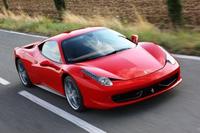Ferrari 458 Italia unveiled at Frankfurt Motor Show
 The Ferrari 458 Italia, debuts today at the IAA Frankfurt Motor Show, is an 8-cylinder two-seater berlinetta with a mid-rear mounted engine, and represents a genuine break with the past in terms of Maranello’s previous high-performance sports cars. Designed to fulfil the expectations and ambitions of our most passionate clients, the 458 Italia continues the Ferrari tradition of putting the thrill into driving as a result of track-derived technological innovations.
The Ferrari 458 Italia, debuts today at the IAA Frankfurt Motor Show, is an 8-cylinder two-seater berlinetta with a mid-rear mounted engine, and represents a genuine break with the past in terms of Maranello’s previous high-performance sports cars. Designed to fulfil the expectations and ambitions of our most passionate clients, the 458 Italia continues the Ferrari tradition of putting the thrill into driving as a result of track-derived technological innovations.Maranello’s racing experience can be felt not only in terms of pure technological transfer but also on a more emotional level, because of the strong emphasis on creating an almost symbiotic relationship between driver and car. This is one of the areas where Michael Schumacher’s contribution, right from the early stages of the project, was of fundamental importance.
Thanks to a new 4,499 cc V8 engine, which punches out 570 CV, the F1 dual-clutch gearbox and a 1,380 kg dry weight, the 458 Italia boasts an extraordinary weightpower ratio of 2.42 kg (a power-weight ratio of 413 CV per ton). This means it sprints from 0 to 100 km/h in under 3.4 seconds and hits a maximum speed of over 325 km/h.
The 458 Italia delivers superb vehicle dynamics with an ideal weight balance for a midrear engined sports car – 58 per cent rear, 42 per cent front. Evolved electronic control systems also help guarantee maximum performance in all driving conditions. Its new suspension set-up, featuring twin wishbones with L arms at the front and a multilink set-up the rear, is tuned for ultimate road-holding and superlative handling. This, together with a more direct steering ratio, ensures the car is extremely responsive whilst maintaining superior ride comfort.
As is the case with the Scuderia’s Formula 1 single-seaters, the engineers focused their efforts on achieving maximum efficiency right across the board with this car. The result is that the Ferrari 458 Italia produces only 307 g/km of CO2 and has a fuel consumption of just 13.3 l/100 km (combined cycle), a benchmark for the entire segment.
Aside from the work done to reduce both internal friction in the engine and overall weight, this result has been achieved thanks to aerodynamic research which focused on cutting drag and maximising downforce.
The 458 Italia is thus a synthesis of technological innovation, creative flair, style and passion, a combination of characteristics for which Italy as a nation is renowned. Ferrari’s Chairman, Luca di Montezemolo, chose to pay homage to this fact by adding the name of the car’s homeland to the traditional figure representing the displacement and number of cylinders.






